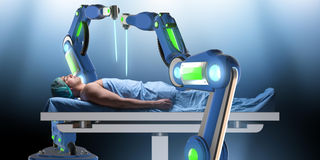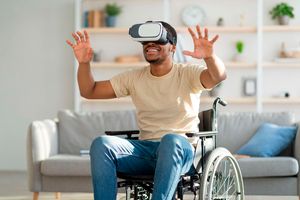10 technologies that will transform medicine in 2025

Beyond cancer treatment, AI-powered precision medicine is revolutionising chronic disease management
What you need to know:
- From artificial intelligence to quantum computing, these innovations are poised to enhance patient outcomes, reduce costs and make healthcare more accessible.
As we stand at the cusp of a new era in healthcare, revolutionary technologies are reshaping how we diagnose, treat and prevent diseases. From artificial intelligence to quantum computing, these innovations are poised to enhance patient outcomes, reduce costs and make healthcare more accessible. Here are the top 10 technologies that will revolutionise healthcare in 2025 and beyond:
1. Artificial Intelligence (AI) and precision medicine: the perfect marriage
The integration of AI with precision medicine represents perhaps the most significant breakthrough in modern healthcare. Machine learning algorithms are now capable of analysing vast amounts of patient data to deliver highly personalised treatment plans with unprecedented accuracy.
Consider the case of Memorial Sloan Kettering Cancer Center in New York, where AI systems analyse millions of cancer cases to recommend treatment protocols that are specifically tailored to each patient's genetic makeup, lifestyle and environmental factors. AI can identify specific genetic mutations driving cancer in patients, helping oncologists choose the most effective therapies. These systems can predict treatment outcomes with over 90 per cent accuracy, dramatically improving survival rates.
Beyond cancer treatment, AI-powered precision medicine is revolutionising chronic disease management. Smart algorithms can now predict diabetes complications years before they occur, allowing for preventive interventions that significantly reduce healthcare costs and improve patient outcomes.
Precision medicine is enabling tailored treatments based on an individual’s genetic makeup, lifestyle, and environment. This year, AI’s predictive capabilities will also enhance early detection of chronic conditions like diabetes and cardiovascular diseases, enabling timely interventions.
2. Brain-Computer Interfaces: Bridging the gap between mind and machine
Brain-computer interfaces (BCIs) have moved from science fiction to scientific reality. BCIs allow direct communication between the brain and external devices, offering new possibilities for treating neurological conditions. In 2025, BCIs will be instrumental in restoring mobility for paralysed patients and improving the lives of those with neurodegenerative diseases like amyotrophic lateral sclerosis or Parkinson’s.
US-based companies like Neuralink and Synchron are developing minimally invasive BCIs that restore movement and communication abilities to patients with severe neurological conditions. Neuralink’s goal is to create implantable brain chips that can help treat neurological conditions and potentially enhance human cognitive abilities. Its BCI technology involves surgically implanting tiny electrodes into the brain to read and transmit neural signals. Synchron focuses on a less invasive approach by placing a stent-like device within the blood vessels of the brain, which can be inserted through the jugular vein, making it a potentially more accessible option for patients.
The latest generation of BCIs can interpret neural signals with remarkable precision, allowing paralysed individuals to control robotic limbs with their thoughts alone. Early trials have shown success rates exceeding 80 per cent in restoring basic motor functions to patients with spinal cord injuries.
More remarkably, BCIs are now being used to treat mental health conditions like depression or PTSD. By monitoring brain activity patterns, these devices can detect the onset of depression or anxiety and deliver targeted neurostimulation to alleviate symptoms before they become severe.
3. Smart implants: The rise of internal wearables
Smart implants will be one of the most transformative advances in medicine this year, evolving far beyond their traditional passive roles into sophisticated systems that actively monitor and respond to changes in the body. These next-generation devices combine miniaturised sensors, wireless connectivity and artificial intelligence to create an unprecedented level of continuous health monitoring and intervention.
At the heart of this revolution is the integration of advanced sensing technology. Modern implants can monitor a vast array of physiological parameters - from basic vital signs to complex biochemical markers. In cardiac care, these devices track not just heart rhythm but also blood flow patterns, pressure changes and early signs of heart failure. Orthopedic implants measure weight distribution, wear patterns and markers of inflammation, providing a comprehensive picture of joint health and healing progress.
The real breakthrough lies in these devices' ability to process and act on data in real-time. Unlike traditional implants that simply perform a mechanical function, smart implants utilise embedded processors to analyse information immediately. For instance, a cardiac implant can detect an irregular heartbeat and deliver a corrective electrical impulse within milliseconds, potentially preventing a serious cardiac event before it occurs. Similarly, smart joint implants can alert patients and physicians to early signs of infection, enabling intervention before complications develop.
Wireless connectivity has transformed how these implants integrate into the broader healthcare ecosystem. Through secure protocols, these devices maintain constant communication with external monitoring systems. Physicians can access detailed health data through specialised applications, allowing them to track patient progress and make treatment adjustments without requiring in-person visits. Patients themselves can monitor their health metrics through smartphone apps, becoming more engaged participants in their own care.
This technology is particularly transformative in post-surgical care. Remote monitoring through smart implants reduces the need for frequent follow-up visits while providing more comprehensive health data than periodic check-ups could achieve. When issues do arise, the continuous stream of data helps physicians make more informed decisions about intervention strategies, often allowing problems to be addressed before they become serious complications.
4. Advanced wearables: Beyond step counting
The evolution of wearable technology in healthcare represents a dramatic shift from simple fitness tracking to comprehensive health monitoring and management. Modern wearables have transformed into sophisticated medical devices that serve as personal health laboratories worn on the body, capable of continuous, non-invasive monitoring of multiple health parameters simultaneously.
The advancement in biosensor technology has revolutionised what we can measure through the skin. Today's devices use a combination of optical, electrical and chemical sensors to track various biomarkers. For instance, advanced optical sensors can now detect subtle changes in blood flow patterns to accurately measure blood pressure throughout the day, while electrochemical sensors can analyse sweat composition to monitor stress hormone levels and electrolyte balance.
Glucose monitoring through wearables has become particularly sophisticated, eliminating the need for finger pricks in diabetes management. These devices use interstitial fluid sensors or spectroscopic technology to provide continuous glucose readings, with some systems even predicting potential blood sugar spikes or crashes before they occur. The integration with insulin pumps has created closed-loop systems that automatically adjust insulin delivery based on real-time glucose levels.
The real power of modern wearables lies in their ability to integrate with broader healthcare systems. When a patient's smartwatch detects an irregular heart rhythm, it can automatically alert their cardiologist and add the event to their electronic health record. This continuous data stream allows healthcare providers to spot trends and potential problems that might be missed during routine check-ups. For instance, patterns in heart rate variability and sleep quality might indicate developing health issues weeks before traditional symptoms appear.
The impact on chronic disease management has been particularly significant. Patients with conditions like hypertension can now share continuous blood pressure data with their doctors, allowing for more precise medication adjustments. For those with respiratory conditions, wearables can monitor breathing patterns and environmental factors, predicting potential asthma attacks or chronic obstructive pulmonary disease exacerbations before they become severe.
Mental health monitoring has also advanced significantly through wearable technology. By tracking parameters like heart rate variability, sleep patterns and activity levels, these devices can identify early signs of anxiety or depression. Some wearables now include features for stress management such as guided breathing exercises triggered by detected stress patterns or recommendations for breaks based on sustained high-stress periods.
5. Genomics and gene editing: Rewriting the code of life
The cost of sequencing a human genome has plummeted, paving the way for widespread genomic research and applications. Advances in genomic medicine and gene editing technologies are ushering in an era of truly personalised healthcare. This revolution is built on three main pillars: precise gene editing capabilities, affordable genetic screening, and personalised drug treatments based on genetic profiles.
CRISPR-Cas9 technology has emerged as a powerful tool for correcting genetic mutations that cause disease. Think of it as a highly precise genetic scissors that can cut and repair DNA at specific locations. In clinical settings, this technology is now being used to treat conditions like sickle cell disease, where faulty genes can be corrected in blood-forming stem cells. What makes this particularly revolutionary is the ability to make these corrections with minimal unintended effects on other parts of the genome.
The dramatic reduction in genetic sequencing costs to under Sh10,000 represents a democratisation of genetic information. This price point makes it feasible to include genetic screening as part of routine medical care, similar to standard blood tests. Healthcare providers can now map a patient's entire genetic code, identifying potential health risks before symptoms appear. For instance, a routine genetic screening might reveal an increased risk for breast cancer, allowing for enhanced monitoring and preventive measures years before traditional screening would typically begin.
In cancer treatment, genomic medicine has enabled a more nuanced approach. Rather than treating cancer based solely on its location in the body, doctors can now analyse the specific genetic mutations driving a patient's cancer. This allows for the selection of targeted therapies that are most likely to be effective against those particular mutations.
6. Microbiome research: The second genome revolution
The human microbiome represents one of the most fascinating frontiers in medical science, revealing itself as a complex ecosystem that profoundly influences our health. Recent research has shown that these trillions of microscopic organisms living within us don't just affect digestion – they impact everything from our immune system to our mental health.
Our understanding of the microbiome has evolved dramatically. Scientists now view it as essentially another organ, one that contains over 100 times more genes than the human genome itself. This vast genetic diversity explains why the microbiome can have such wide-ranging effects on our health. For instance, certain gut bacteria produce neurotransmitters like serotonin, directly influencing mood and mental health. Others help train our immune system, determining how we respond to infections and environmental triggers.
The application of AI to microbiome research has opened new doors in personalised medicine. Advanced AI algorithms can now analyse the complex interactions between different bacterial species and their host, identifying patterns that would be impossible to detect through traditional research methods. This has led to the development of highly personalised probiotic treatments that are tailored to an individual's unique microbial composition.
Consider inflammatory bowel disease as an example. Traditional treatments often take a one-size-fits-all approach, but microbiome research has revealed that different patients have distinct microbial imbalances. By analysing a patient's specific microbiome profile, doctors can now prescribe targeted interventions – whether through specialised probiotics, dietary changes, or fecal microbiota transplants – that address their particular bacterial imbalances.
7. Quantum computing in healthcare: Solving the unsolvable
Quantum computing represents a paradigm shift in healthcare technology, offering computational capabilities that transcend the limitations of traditional computers. Unlike classical computers that process information in bits (0s and 1s), quantum computers use quantum bits or qubits, which can exist in multiple states simultaneously through a phenomenon called superposition. This unique property, combined with quantum entanglement, allows these systems to solve complex medical problems exponentially faster.
In drug discovery, quantum computing is transforming how we develop new medications. Traditional drug development requires simulating molecular interactions, a process that can take years with classical computers. Quantum computers can model these interactions at the quantum level, accurately predicting how potential drug molecules will bind to target proteins. For example, when developing new antibiotics, quantum algorithms can simultaneously evaluate millions of molecular combinations to identify those most likely to be effective against resistant bacteria.
Quantum computing is also enhancing medical imaging through quantum sensors. These devices utilise quantum effects to achieve higher sensitivity and resolution than conventional imaging technologies. In practical terms, this means detecting smaller tumours earlier, observing subtle changes in brain activity, or identifying early signs of disease at the cellular level. For instance, quantum-enhanced MRI machines could detect early-stage cancers that would be invisible to current imaging technology.
8. Virtual reality and augmented reality: Immersive healing
Virtual reality (VR) has emerged as a powerful tool for pain management, mental health treatment and rehabilitation. Studies have shown that VR-based pain management can reduce pain perception by up to 40 per cent, offering a drug-free alternative for chronic pain patients.
In mental health, VR exposure therapy has become the gold standard for treating phobias and post-traumatic stress disorder, with success rates exceeding traditional therapies. VR-based rehabilitation programmess are helping stroke patients regain motor function faster than conventional physical therapy.
The technology is also being used to treat addiction, with VR-based coping skill training showing promising results in preventing relapse.
Augmented reality (AR) is revolutionising medical education, surgical planning and patient care. Surgeons using AR-enabled systems can now see real-time overlays of crucial anatomical structures during procedures, significantly improving surgical precision.
In medical education, AR systems provide students with interactive 3D models of human anatomy, allowing them to explore complex biological systems in unprecedented detail. For patients, AR apps can provide visual guides for medication adherence and physical therapy exercises.
The integration of AR with telemedicine has created "augmented telemedicine," allowing doctors to perform virtual physical examinations with nearly the same accuracy as in-person visits.
9. Blockchain: Secure treatment
Blockchain technology is revolutionising healthcare by addressing persistent challenges like data security, interoperability, and patient engagement. Its decentralised and encrypted structure ensures medical records are stored securely, accessed only by authorised parties, and gives patients complete control over their data, enabling them to decide who can view their health information and for what purpose.
By facilitating standardised and immutable data sharing, blockchain also overcomes interoperability issues, allowing seamless communication between healthcare providers and ensuring the integrity of shared medical records. Blockchain-powered health gamification apps are transforming patient engagement by incentivising healthy behaviours through cryptocurrency rewards, encouraging lifestyle changes, medication adherence, and preventive care.
10. Health gamification: Engaging patients like never before
Gamification—the use of game design elements in non-game contexts—is gaining traction in healthcare. In 2025, gamified apps and platforms will play a pivotal role in promoting healthy behaviours and improving patient engagement.
Gamification is a strategy to transform health management into an interactive, rewarding, and empowering experience for patients. Rooted in behavioural psychology, gamification leverages principles such as reward systems, competition, and progress tracking to motivate individuals to adopt healthier behaviours and engage actively in their care.
One of the primary challenges in healthcare is ensuring that patients adhere to treatment plans, including taking medication, exercising regularly, or maintaining a healthy diet. Gamified apps address this by creating incentives that tap into intrinsic and extrinsic motivations. For instance, an app might reward users with points or crypto tokens for completing daily medication reminders or achieving step-count goals, which can then be exchanged for discounts or tangible rewards.
Virtual reality (VR) games extend gamification to therapeutic and rehabilitative settings. Traditional physical therapy can often be repetitive, painful, and discouraging, leading to poor compliance and suboptimal recovery outcomes. VR reimagines these exercises by embedding them into engaging, immersive environments. For instance, a patient recovering from a stroke might play a VR game where they navigate through a virtual world, performing movements that correspond to their therapy exercises. By focusing on the game goals rather than the physical difficulty of the task, patients experience less psychological resistance and are more likely to complete their sessions.
Gamification also serves a critical role in chronic disease management. For conditions like diabetes or hypertension, apps can integrate features such as daily challenges to log blood sugar levels or monitor blood pressure, with rewards for consistent tracking. These systems transform what can feel like a burdensome responsibility into an engaging activity, helping patients build habits that contribute to long-term health improvements.






